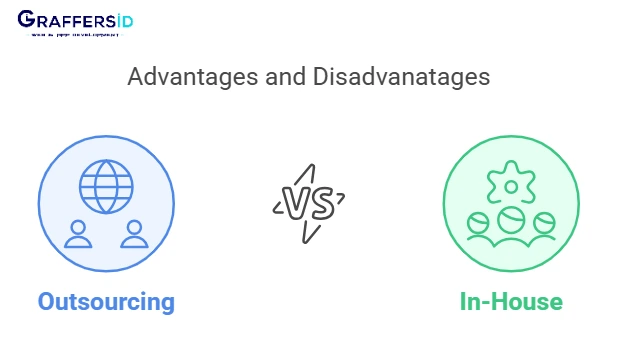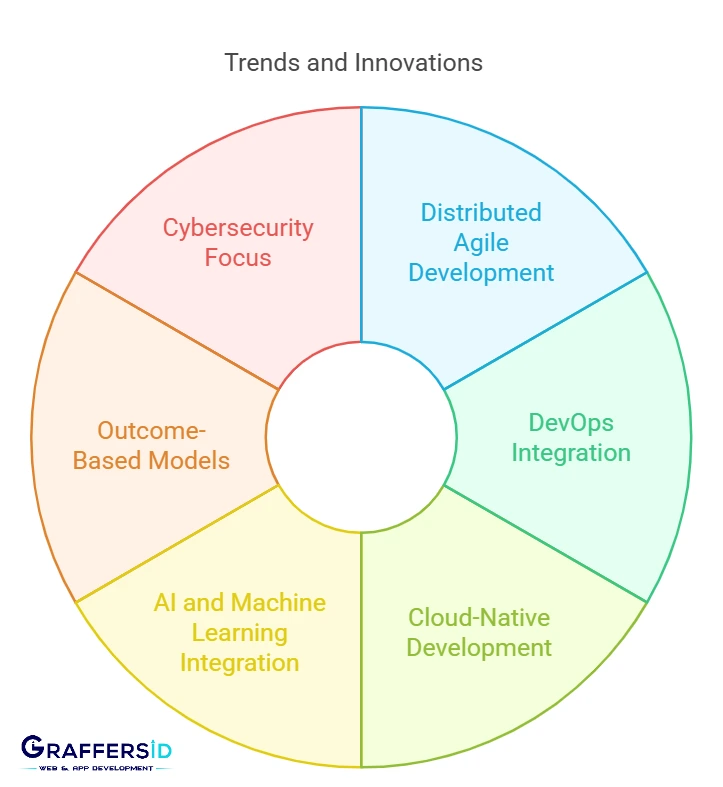One strategy that has gained immense popularity is outsourcing software development. Outsourcing allows companies to tap into a global talent pool, reduce costs, and accelerate time-to-market. However, the success of outsourcing heavily relies on choosing the right software development partner. In this blog, we will explore key strategies to ensure a seamless and successful outsourcing journey.
Strategies For Choosing Outsourcing Software Development
Define Clear Objectives and Requirements:
Before venturing into outsourcing, it is crucial to have a comprehensive understanding of your project’s objectives and requirements. Clearly define your goals, functionality, and any specific technical or industry-related considerations. This will serve as the foundation for selecting a software development partner with the right expertise and capabilities.
Evaluate Vendor Expertise:
Not all software development companies are created equal. Assess the expertise and experience of potential outsourcing partners. Look for a track record of successful projects in your industry and the technologies relevant to your project. Request case studies, client testimonials, and references to gauge the vendor’s ability to deliver high-quality solutions.
Cultural Fit and Communication:
Effective communication is paramount in outsourcing relationships. Evaluate the cultural fit between your organization and the outsourcing partner. Time zone differences, language barriers, and cultural nuances can impact collaboration. Choose a vendor with a proactive communication approach, a good command of the English language, and a work culture that aligns with your own.
Quality Assurance and Testing:
Ensure that the outsourcing partner follows rigorous quality assurance and testing processes. Robust testing practices are essential to deliver a reliable and bug-free software product. Inquire about the testing methodologies, tools used, and the extent of testing coverage to guarantee the quality of the final deliverable.
Security and Compliance:
Protecting sensitive data and adhering to industry regulations are critical considerations when outsourcing software development. Evaluate the vendor’s security measures, data protection policies, and compliance with relevant standards (such as GDPR or HIPAA). A reputable outsourcing partner will prioritize security and compliance throughout the development lifecycle.
Scalability and Flexibility:
Choose a software development partner that can scale with your business. Assess their capacity to handle changes in project scope, increased workloads, and evolving requirements. Flexibility is key in adapting to unforeseen challenges or modifications, ensuring the successful completion of your project.
Cost Transparency and Model:
While cost savings are a major motivation for outsourcing, it’s essential to have transparency in pricing models. Understand how the outsourcing partner charges for their services and whether it aligns with your budget and financial goals. Consider factors such as hourly rates, project-based pricing, and potential hidden costs.
Intellectual Property (IP) Protection:
Clarify the terms of intellectual property ownership from the outset. Establish a comprehensive agreement regarding the ownership of code, data, and any other project-related assets. A well-defined IP protection strategy safeguards your investment and avoids future legal complications.
Monitor Project Management Practices:
Effective project management is vital for the success of any outsourcing endeavor. Evaluate the outsourcing partner’s project management practices, methodologies, and tools. Regular updates, progress reports, and a collaborative project management approach contribute to a transparent and well-coordinated development process.
Legal and Contractual Considerations:
Before finalizing any outsourcing agreement, carefully review and negotiate the legal and contractual aspects. Ensure that the contract includes all essential details such as deliverables, timelines, payment terms, confidentiality clauses, and dispute resolution mechanisms. Engage legal counsel to provide guidance and mitigate potential risks.
What are the key considerations when selecting a software development outsourcing partner?
Choosing the right outsourcing partner is a critical decision that can significantly impact the success of your project. Let’s explore the key considerations that should guide your decision-making process when selecting a software development outsourcing partner.
1. Expertise and Experience:
When evaluating potential outsourcing partners, it’s crucial to assess their expertise and experience in your industry and the technologies relevant to your project. Look for a partner with a proven track record of successfully delivering projects similar to yours. Consider the complexity of your requirements and ensure that the outsourcing company has the necessary skills and experience to meet your specific needs.
2. Quality of Work:
Quality is paramount in software development. Evaluate the outsourcing partner’s commitment to quality by reviewing their portfolio, checking client testimonials, and exploring case studies. Look for certifications, industry recognitions, and adherence to best practices and standards. A quality-focused partner will contribute to the long-term success and maintainability of your software solution.
3. Communication and Collaboration:
Effective communication is the cornerstone of successful outsourcing partnerships. Assess the outsourcing partner’s communication channels, responsiveness, and cultural compatibility. Time zone differences should also be considered, as seamless communication is vital for addressing issues promptly and ensuring project transparency. A reliable outsourcing partner should facilitate open and clear communication throughout the development lifecycle.
4. Scalability and Flexibility:
As your business grows, so too should your software. Choose a top IT outsourcing company with the scalability and flexibility to accommodate your evolving needs. Assess their ability to scale the team, adopt new technologies, and adapt to changing project requirements. A flexible partner can help you navigate unforeseen challenges and capitalize on emerging opportunities.
5. Security and Compliance:
Security is a top concern in software development, especially when outsourcing. Ensure that your potential partner follows robust security practices, complies with industry standards, and adheres to data protection regulations. Conduct a thorough security assessment, including infrastructure security, data protection measures, and the implementation of secure coding practices.
6. Cost and Value:
While cost is a significant factor in outsourcing decisions, it should not be the sole determinant. Assess the overall value that an outsourcing partner brings to the table. Consider factors such as the quality of work, timeliness, and the long-term benefits of the partnership. A partner offering the lowest cost may not necessarily provide the best value in the long run.
7. Intellectual Property Protection:
Clarify the ownership and protection of intellectual property rights from the outset. Ensure that the outsourcing partner has clear policies in place regarding code ownership, confidentiality, and non-disclosure agreements. This is crucial to safeguard your unique ideas, innovations, and proprietary information.
8. Project Management and Processes:
A well-defined project management approach and established processes are essential for successful software development. Assess the outsourcing partner’s project management methodologies, development processes, and tools. Transparency, regular progress reporting, and a collaborative approach to problem-solving are indicative of a well-organized and efficient outsourcing partner.
What strategies can be employed to ensure effective communication with an offshore software development team?
Effective communication becomes the linchpin for achieving project goals, maintaining transparency, and building a cohesive team dynamic. In this blog, we will explore a range of strategies that can be employed to ensure seamless communication with offshore software development teams.
1. Establish Clear Communication Protocols:
Before diving into the intricacies of a project, it is essential to establish clear communication protocols. This includes defining the channels of communication, preferred tools, and the frequency of updates. Whether it’s daily stand-up meetings, weekly progress reports, or real-time collaboration through project management tools, having a structured communication plan ensures everyone is on the same page.
2. Cultural Sensitivity and Awareness:
Offshore teams often bring diverse cultural backgrounds to the table. Understanding and respecting these cultural differences can significantly impact communication effectiveness. Sensitivity to time zones, holidays, and communication styles is crucial. Regularly acknowledging and celebrating cultural events can help build a strong team spirit, fostering a collaborative atmosphere.
3. Utilize Technology Wisely:
Leveraging the right technological tools is vital for successful communication. Video conferencing, project management tools, and messaging platforms can bridge the physical gap and facilitate real-time collaboration. Ensure that all team members are familiar with and have access to the chosen tools, fostering a tech-savvy and connected environment.
4. Define Clear Project Objectives and Expectations:
Clarity in project objectives and expectations is paramount. Articulate goals, timelines, and deliverables to avoid misunderstandings. Having a well-documented project scope and regularly revisiting it during the development process helps keep everyone aligned with the project’s overall vision.
5. Establish a Single Point of Contact:
To streamline communication and avoid confusion, designate a single point of contact for each team. This contact person should serve as a bridge between onshore and offshore teams, facilitating smoother communication flow. Having a central point of coordination minimizes the risk of miscommunication and ensures that queries and feedback are addressed promptly.
6. Encourage Open Communication:
Foster an environment where team members feel comfortable expressing their ideas, concerns, and feedback. Encourage open dialogue during meetings and create platforms for team members to share insights. A culture of openness promotes creativity, problem-solving, and a sense of ownership among team members.
7. Regular Video Conferencing and Face-to-Face Meetings:
While technology facilitates remote communication, nothing beats face-to-face interaction. Regular video conferencing and occasional face-to-face meetings, if possible, help build stronger personal connections among team members. This can mitigate the challenges of virtual communication and enhance team cohesion.
8. Provide Comprehensive Documentation:
Create comprehensive documentation for the project, including specifications, coding guidelines, and design principles. This documentation serves as a reference point for all team members and ensures that everyone is working towards a shared understanding of the project requirements.
Advantages and Disadvantages of Outsourcing Software Development Compared to In-house Development
Let’s delve into the intricacies of both outsourcing and in-house development, examining the pros and cons that businesses need to consider before making a decision.

Outsourcing Software Development:
Advantages:
- Cost Efficiency: Outsourcing software development often proves to be more cost-effective than maintaining an in-house team. Companies can tap into a global talent pool and choose from various pricing models, such as fixed-price or time and material contracts.
- Access to Specialized Skills: Outsourcing enables access to a diverse range of skills and expertise. Companies can choose a development partner with specific technical proficiencies that align with their project requirements, ensuring high-quality output.
- Flexibility and Scalability: External development teams can easily scale up or down based on project needs. This flexibility allows businesses to adapt to changing demands without the challenges of hiring and training new in-house personnel.
- Focus on Core Competencies: By outsourcing non-core functions like software development, companies can concentrate on their core competencies, promoting efficiency and innovation in their primary business activities.
- Faster Time-to-Market: Outsourcing can expedite the development process as external teams often have experience in similar projects. This can be crucial in launching products or services ahead of competitors.
Disadvantages:
- Communication Challenges: Distances and cultural differences can lead to communication challenges, impacting project coordination and understanding. Time zone differences may also result in delays in feedback and collaboration.
- Quality Control Issues: Maintaining control over the quality of the deliverables can be challenging when working with an external team. Ensuring that the outsourced team adheres to the same standards as an in-house team requires effective monitoring.
- Security Concerns: Sharing sensitive data with an external partner raises security concerns. Companies need to implement robust security measures and contractual agreements to safeguard their intellectual property.
In-House Software Development:
Advantages:
- Direct Control: In-house development provides a higher level of control over the entire development process. Teams can easily adapt to changes, and communication is often more seamless within a single organizational structure.
- Immediate Feedback and Collaboration: Proximity facilitates quick feedback loops and fosters collaboration among team members. Face-to-face interactions can enhance problem-solving and innovation.
- Cohesive Company Culture: Building an in-house team promotes a cohesive company culture. Team members share the same organizational values and goals, contributing to a unified work environment.
- Confidentiality and Security: Keeping development in-house helps mitigate security risks associated with external collaborations. Companies have more control over access to sensitive data, reducing the likelihood of breaches.
Disadvantages:
- Higher Costs: Maintaining an in-house development team incurs higher costs, including salaries, benefits, and infrastructure. This model may not be feasible for small or medium-sized enterprises with budget constraints.
- Limited Access to Global Talent: In-house teams are limited to the talent available locally, which may restrict access to specialized skills. This could impact the ability to tackle complex projects that require diverse expertise.
- Resource Limitations: In-house teams may face resource limitations during peak workloads or when handling multiple projects simultaneously. This can result in longer development cycles and delays in product releases.
What Are The Common Challenges and Pitfalls to Avoid in Outsourcing Software Development?
Let’s explore some common hurdles faced by companies in outsourcing software development and provide insights on how to avoid them.
Communication Barriers:
Effective communication is the backbone of successful software development. When outsourcing, the lack of face-to-face interaction and differences in time zones and languages can lead to misunderstandings, delays, and suboptimal results.
Solution: Prioritize clear and open communication channels. Regular video calls, well-defined documentation, and project management tools can bridge the communication gap. Establishing a robust communication plan from the outset is crucial for fostering collaboration.
Lack of Transparency:
Some outsourcing partners may not provide sufficient visibility into their processes, making it challenging for the client to track project progress, identify potential issues, or understand how resources are allocated.
Solution: Set clear expectations regarding reporting and transparency. Implement project tracking tools, conduct regular status meetings, and request detailed progress reports. A transparent partnership builds trust and helps both parties stay aligned.
Quality Assurance and Testing:
Ensuring the quality of the software is a common concern in outsourcing. Differences in testing standards, and methodologies, and the absence of in-house quality assurance teams can result in the delivery of subpar products.
Solution: Clearly define quality standards, testing procedures, and acceptance criteria in the initial project documentation. Establish a robust testing process, conduct regular reviews, and consider involving your in-house QA team or hiring external testers to ensure a thorough evaluation.
Intellectual Property Concerns:
Protecting intellectual property is a paramount concern when outsourcing software development. Without proper legal safeguards, there is a risk of unauthorized use or disclosure of proprietary information.
Solution: Draft a comprehensive and well-defined legal agreement that explicitly outlines the ownership of intellectual property rights. Consult legal experts to ensure the contract is airtight and that both parties fully understand and agree to the terms.
Unrealistic Expectations and Scope Creep:
Ambiguous project scopes and unrealistic expectations can lead to scope creep, causing delays and budget overruns. Both parties must have a clear understanding of project requirements from the beginning.
Solution: Invest time in thorough project planning. Clearly define project scope, requirements, and deliverables. Implement a change management process to handle modifications to the scope, ensuring that all changes are documented, approved, and communicated effectively.
Vendor Reliability and Stability:
The stability and reliability of an outsourcing partner can impact project success. Issues such as financial instability, staff turnover, or management changes can introduce uncertainty.
Solution: Conduct thorough due diligence before selecting an outsourcing partner. Assess their financial stability, review client testimonials, and inquire about their team’s experience and expertise. A stable and reliable vendor is more likely to deliver consistent results.
Trends and Innovations in Outsourcing Models for Software Development
As we step into the future, several trends and innovations are reshaping the outsourcing models for software development. Let’s explore these transformative developments that are set to redefine the way businesses approach and leverage external talent.

1. Distributed Agile Development:
Agile methodologies have become the bedrock of software development, emphasizing flexibility, collaboration, and iterative progress. In outsourcing, the integration of Agile practices is now taking a step further with distributed Agile development. Teams spread across geographical locations collaborate seamlessly, thanks to advanced communication tools, ensuring continuous delivery and improved adaptability to changing project requirements. This trend not only accelerates development but also enhances the overall quality of the software product.
2. DevOps Integration:
The fusion of development and operations, commonly known as DevOps, has become a game-changer in software development. Outsourcing partners are increasingly adopting DevOps practices to foster collaboration between development and operations teams, resulting in faster and more reliable software delivery. Automation of processes, continuous integration, and continuous deployment are key components of this trend, enabling businesses to achieve shorter development cycles and quicker time-to-market.
3. Cloud-Native Development:
The transition to cloud-native development is reshaping how software is built, deployed, and scaled. Outsourcing models are embracing cloud technologies to harness the benefits of scalability, flexibility, and cost-effectiveness. Cloud-native development allows for the creation of applications that are optimized for cloud environments, enabling seamless integration with various cloud services. This trend not only enhances the performance of software but also facilitates easier maintenance and updates.
4. AI and Machine Learning Integration:
As artificial intelligence (AI) and machine learning (ML) become integral to numerous industries, outsourcing models are incorporating these technologies into software development projects. AI and ML algorithms are leveraged to automate repetitive tasks, enhance data analysis, and improve overall system intelligence. Outsourcing partners with expertise in AI and ML bring a competitive edge, enabling businesses to develop smart, data-driven applications that can adapt and learn from user interactions.
5. Outcome-Based Models:
Traditional outsourcing models often revolved around fixed-price or time-and-materials contracts. However, a shift towards outcome-based models is gaining traction. In this approach, the outsourcing partner’s compensation is tied to the successful delivery of predetermined outcomes or key performance indicators (KPIs). This model aligns the interests of both parties, emphasizing the importance of quality and results over mere output. Businesses benefit from increased accountability and a more strategic partnership with their outsourcing providers.
6. Cybersecurity Focus:
With the increasing frequency and sophistication of cyber threats, cybersecurity is now a non-negotiable aspect of software development. Outsourcing partners are investing heavily in robust cybersecurity measures to protect sensitive data and ensure the integrity of software applications. This includes adherence to industry standards, regular security audits, and the integration of secure coding practices throughout the development lifecycle. Businesses are recognizing the importance of partnering with outsourcing providers who prioritize cybersecurity to mitigate potential risks.
Conclusion:
As software development continues to evolve, outsourcing models are adapting to meet the dynamic needs of businesses. The trends discussed, including distributed Agile development, DevOps integration, cloud-native development, AI and ML integration, outcome-based models, and cybersecurity focus, collectively represent a forward-thinking approach to outsourcing.
At GraffersID, we specialize in offshore software development. With the best developers on board, we have assisted several clients in bringing their vision to life. Contact us today!





